

Two alternative futures for MBaaS and MAM convergence. Mobile Backend as a Service (MBaaS) got it's start serving up the backend of mobile applications with maybe a basic level of security.
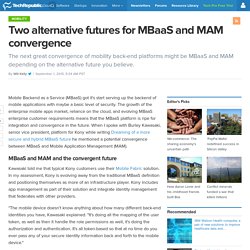
The growth of the enterprise mobile apps market, reliance on the cloud, and evolving MBaaS enterprise customer requirements means that the MBaaS platform is ripe for integration and convergence in the future. When I spoke with Burley Kawasaki, senior vice president, platform for Kony while writing Dreaming of a more secure and hybrid MBaaS future he mentioned a potential convergence between MBaaS and Mobile Application Management (MAM). MBaaS and MAM and the convergent future Kawasaki told me that typical Kony customers use their Mobile Fabric solution. In my assessment, Kony is evolving away from the traditional MBaaS definition and positioning themselves as more of an infrastructure player. "The mobile device doesn't know anything about how many different back-end identities you have, Kawasaki explained.
CP : Pourquoi le Mobile Backend as a Service (MBaaS) est-il en train de s'imposer? Paris, le 11 octobre 2012 - L'arrivée du premier iPhone en 2007 a amené un profond changement des usages de l'Internet : jusque-là, le mode dominant d'accès à Internet se faisait par le biais d'un navigateur Web à partir d’un terminal fixe (PC Windows), ou d'un terminal disposant d’une mobilité limitée à cause de son encombrement (PC portables).

Fichiers et applications étaient centralisés sur ce poste de travail, la mobilité des données se faisant principalement par CD-ROM ou clé USB. La téléphonie grand public servait alors principalement à téléphoner, dans le meilleurs des cas à lire des e-mails, avec comme leader mondial grand public Nokia dont l'essentiel des produits vendus étaient des téléphones mobiles simples et robustes, ou dans l’univers professionnel Blackberry avec son mini clavier caractéristique sa messagerie cryptée. Mobile Backend as a Service. Au moment d’intégrer une N-ième application mobile sur votre SI, vous pensez : « encore une… »

Why Backend as a Service - BaaS cannot be ignored for developing Apps. Deployd. Backend as a Service - Mobile's new Middleware. New MBaaS tool connects mobile apps to back-end services. A new MBaaS tool aims to connect complex, mobile-unfriendly back-end systems with rapidly assembled APIs to move business processes to mobile.

Arrow is a new feature from Appcelerator Inc.'s platform for mobile application development. It provides a framework to build mobile-optimized APIs for employee and consumer-facing applications and simplifies mobile backend as a service (MBaaS). Arrow gives IT and developers a scalable cloud service for running the new APIs. It's made up of two parts: Builder, which allows for rapid assemblage of APIs, data models and connectors; and Cloud, which runs the APIs and provides usage analysis and push notification support. Enterprises find linking back-end services to mobile apps to be one of the top challenges around developing mobile apps, said John Jackson, vice president of mobility research at IDC in Framingham, Mass. Appcelerator connects healthcare systems Limelight uses Arrow to manage, deploy and connect its APIs faster. What is Mobile Backend as a Service (MBaaS)? Mobile Cloud Backend as a Service Ecosystem Map – All roads lead to BaaS.
I am still asked this question from time to time: “What in heaven’s name is Backend as a Service?”
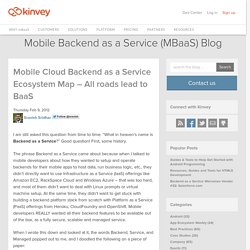
Good question! First, some history. The phrase Backend as a Service came about because when I talked to mobile developers about how they wanted to setup and operate backends for their mobile apps to host data, run business logic, etc., they didn’t directly want to use Infrastructure as a Service (IaaS) offerings like Amazon EC2, RackSpace Cloud and Windows Azure – that was too hard, and most of them didn’t want to deal with Linux prompts or virtual machine setup. At the same time, they didn’t want to get stuck with building a backend platform stack from scratch with Platform as a Service (PaaS) offerings from Heroku, CloudFoundry and OpenShift.
Mobile developers REALLY wanted all their backend features to be available out of the box, as a fully secure, scalable and managed service. Understanding Mobile Back End As A Service. What if you could create an entire back end for your mobile applications that was feature-complete in data synchronization, push-notification support, user management and file-handling before you even started building the mobile experience?
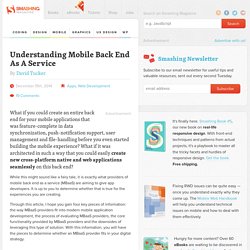
What if it was architected in such a way that you could easily create new cross-platform native and web applications seamlessly on this back end? While this might sound like a fairy tale, it is exactly what providers of mobile back end as a service (MBaaS) are aiming to give app developers. It is up to you to determine whether that is true for the experiences you are creating. Through this article, I hope you gain four key pieces of information: the way MBaaS providers fit into modern mobile application development, the process of evaluating MBaaS providers, the core functionality provided by MBaaS providers and the downsides of leveraging this type of solution. Framing The Discussion Link. [Infographic] Mapping the Tools in the Mobile Development Ecosystem.
The mobile development ecosystem is a large, complicated space.
![[Infographic] Mapping the Tools in the Mobile Development Ecosystem](http://cdn.pearltrees.com/s/pic/th/infographic-development-51095489)
There are innovative startups making tools for native and mobile Web apps along with large enterprise-grade companies that offer solutions from cloud support to frameworks and developer environments. For a mobile developer, it can be confusing to know where to turn and what to use to make the best app possible. Understanding Mobile Back End As A Service. Comparatif MBaaS : quelle plateforme cloud choisir pour lancer son app mobile ? Développer une app mobile n’est rien.
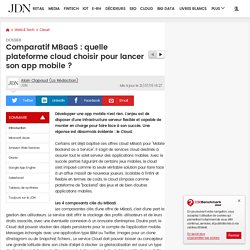
L'enjeu est de disposer d’une infrastructure serveur flexible et capable de monter en charge pour faire face à son succès. Une réponse est désormais évidente : le Cloud. Convertigo 7.3 : une plateforme MBaaS/MADP unifiée. L’éditeur Convertigo annonce la disponibilité d’une version majeure de sa plateforme et présente une solution MBaaS/MADP complètement intégrée.

Bâtie sur des standards industriels éprouvés, cette nouvelle version intègre notamment la technologie FullSync. Cette dernière permet de créer des scénarios de mobilité en mode 100 % déconnecté avec un minimum de développements. Il est alors possible de travailler avec les données de l’entreprise tout en préservant les processus métiers existants et en sécurisant la mise en production. Il s’agit d’une véritable révolution sur le marché qui permet aux Chief Digital Officer, DSI et Intégrateurs de concevoir des applications mobiles performantes en s’appuyant sur un outil complètement intégré.
Convertigo 7.3 est donc adaptée à différents contextes d’usage : e-commerce, force de ventes, applications embarquées, etc. Dreaming of a more secure and hybrid MBaaS future. We traditionally think of Mobile Backend as a Service (MBaaS) as a public cloud service where mobile app developers tap into backend resources like databases and reusable code for common application features.
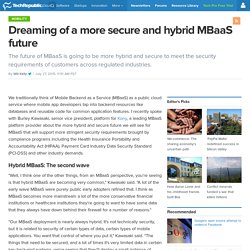
I recently spoke with Burley Kawasaki, senior vice president, platform for Kony, a leading MBaaS platform provider about the more hybrid and secure future we will see for MBaaS that will support more stringent security requirements brought by compliance programs including the Health Insurance Portability and Accountability Act (HIPAA), Payment Card Industry Data Security Standard (PCI-DSS) and other industry demands. Hybrid MBaaS: The second wave "Well, I think one of the other things, from an MBaaS perspective, you're seeing is that hybrid MBaaS are becoming very common," Kawasaki said. Built.io Q&A: 'Internet of APIs' and future of MBaaS market. Built.io is a Mobile Backend-as-a-Service provider and app development platform that’s laser focused on the enterprise market. With MBaaS in general undergoing a shift toward enterprise, and with the Internet of Things looming on the horizon, we caught-up with built.io’s CTO Nishant Patel to ask a few questions about what companies really want out of MBaaS and what the future holds for the sector.
Read on for the full Q&A. Built.io promotes itself as built from the ground up for enterprise. Why exactly is this important for enterprises looking for an MBaaS provider? At the core, all MBaaS offerings provide mobile backend services designed to accelerate application development. Some of the early MBaaS vendors have been trying to expand their addressable market beyond consumer apps into the enterprise. Would you say that, when it comes to business models, the focus on enterprise has proven to be the correct path to take for MBaaS providers? For enterprises, it’s much less about the device. Mobile App Devs Take Note: Five MBaaS Trends Shaping the Future. If you are a mobile developer or simply involved in the mobile app market in some capacity, then you can certainly appreciate just how much the Mobile Backend as a Service (MBaaS) landscape has evolved over the past few years.
What once was viewed as a developer’s playground to build "cool" apps is quickly evolving into an important market category that developers are leveraging to turn their ideas into full-fledged businesses. We are in the middle of a market transformation and backend technology is becoming the predominant platform that developers are using to build, scale, grow and monetize their apps – whether they work in a “garage” business or an enterprise. To get ahead of the curve, here are some trends you need to be following as the MBaas space continues to explode in the future: 1. The rise of mobile backend-as-a-service: Why MBaaS is the developer's new best friend. The pro football hall of famer head coach Bill Parcells once famously said upon leaving the New England Patriots, "They want you to cook the dinner; at least they ought to let you shop for some of the groceries.
" Not long ago, mobile application development wasn't much different. Developers were the chefs of mobile app creation but hardly had a choice of the development tools they could use to build them. Developers have always wanted to be the Picassos of app creation, but have rarely been able to choose their own canvas and paints. This dilemma for developers occurred for disparate reasons. Sometimes developers’ desires for development tools diametrically opposed the operational efficiencies of the company they worked for. This caused tremendous problems. Furthermore, developers absolutely love to work on the user experience and design of an app. Why-mbaas-now-codex1194. Enterprise MBaaS Architecture in the Digital World. Last week, Harsha Avvari, Head of Technology at Cognizant Technology Solutions and Rich Mendis, Chief Product Officer at AnyPresence joined forces to present their view of the future of enterprise architecture in the digital world.
This is a summary of their web session. As the technology landscape evolves at a dramatic pace driven by cloud software services and smart device proliferation, companies are struggling to keep up with the pace of innovation and its exponential complexity. As the post-PC era matures, new web-connected devices such as appliances, wearables, automobiles and other non-traditional channels are emerging. It is imperative for enterprises to enable their developer ecosystems with the appropriate digital infrastructure if they are to take advantage of the opportunities these new channels offer and remain relevant. The App Development ChallengesShort development cycles: Development cycles need to be shorter and more frequent in order to keep pace with expectations.
Modernizing Digital Infrastructure with MBaaS: 2015 and Beyond. MBaaS shoot-out: 5 clouds for building mobile apps. MBaaS (mobile back end as a service) is a fairly new product category that has largely supplanted MEAPs (mobile enterprise application platforms). Over the past two months, I've closely examined five MBaaS systems: AnyPresence, Appcelerator, FeedHenry, Kinvey, and Parse. In this article, I'll wrap up the series by summarizing all five systems, surveying their common ground and key differences, and drawing conclusions. The general idea of MBaaS is that mobile apps need common services that can be shared among apps instead of being custom developed for each.
Mobile apps using MBaaS follow a loosely coupled distributed architecture, and MBaaS systems themselves typically have more distributed architectures than MEAP systems, which tended to be unified middleware servers. Features. Cloud Backend as a Service (BaaS) Sometimes also called mBaaS, in sort this is the way mobile and web applications easily and efficiently build mobile and web applications. On a standard backend platform it lets you easily and efficiently link applications to back end cloud storage and APIs exposed by existing business applications.
It also is the best way to integrate features such as push notification services into your mobile app. Developing Location-Aware Apps with mBaaS. MoBack MBaaS – Analytics Dashboard. Code free MMADP - Mobile Application Development Platform. Molecular MADP (MMADP) – Unify MAM, MEAP and MBaaS. Modularize Retail processes and Stay Ahead Online with Modular MBaaS.
Les « Enterprise MbaaS » facilitent la création d’applications William El Kaim, Consultnoo. The enterprise mobility journey to value fr. Comparatif MBaaS : quelle plateforme cloud choisir pour lancer son app mobile ? Open Source Mobile Application Development Platform and MBaaS - Convertigo. Mobile Application Development Platform & MBaaS. La mairie de Paris et la start-up Apps Panel lancent l’application Paris Taxis. MBaaS Archives - Blog Apps Panel. L’arrivée du premier iPhone en 2007 a amené un profond changement des usages de l’Internet : jusque-là, le mode dominant d’accès à Internet se faisait par le biais d’un navigateur Web à partir d’un terminal fixe (PC Windows), ou d’un terminal disposant d’une mobilité limitée à cause de son encombrement (PC portables). Fichiers et applications étaient centralisés sur ce poste de travail, la mobilité des données se faisant principalement par CD-ROM ou clé USB.
La téléphonie grand public servait alors principalement à téléphoner, dans le meilleurs des cas à lire des e-mails, avec comme leader mondial grand public Nokia dont l’essentiel des produits vendus étaient des téléphones mobiles simples et robustes, ou dans l’univers professionnel Blackberry avec son mini clavier caractéristique sa messagerie cryptée.